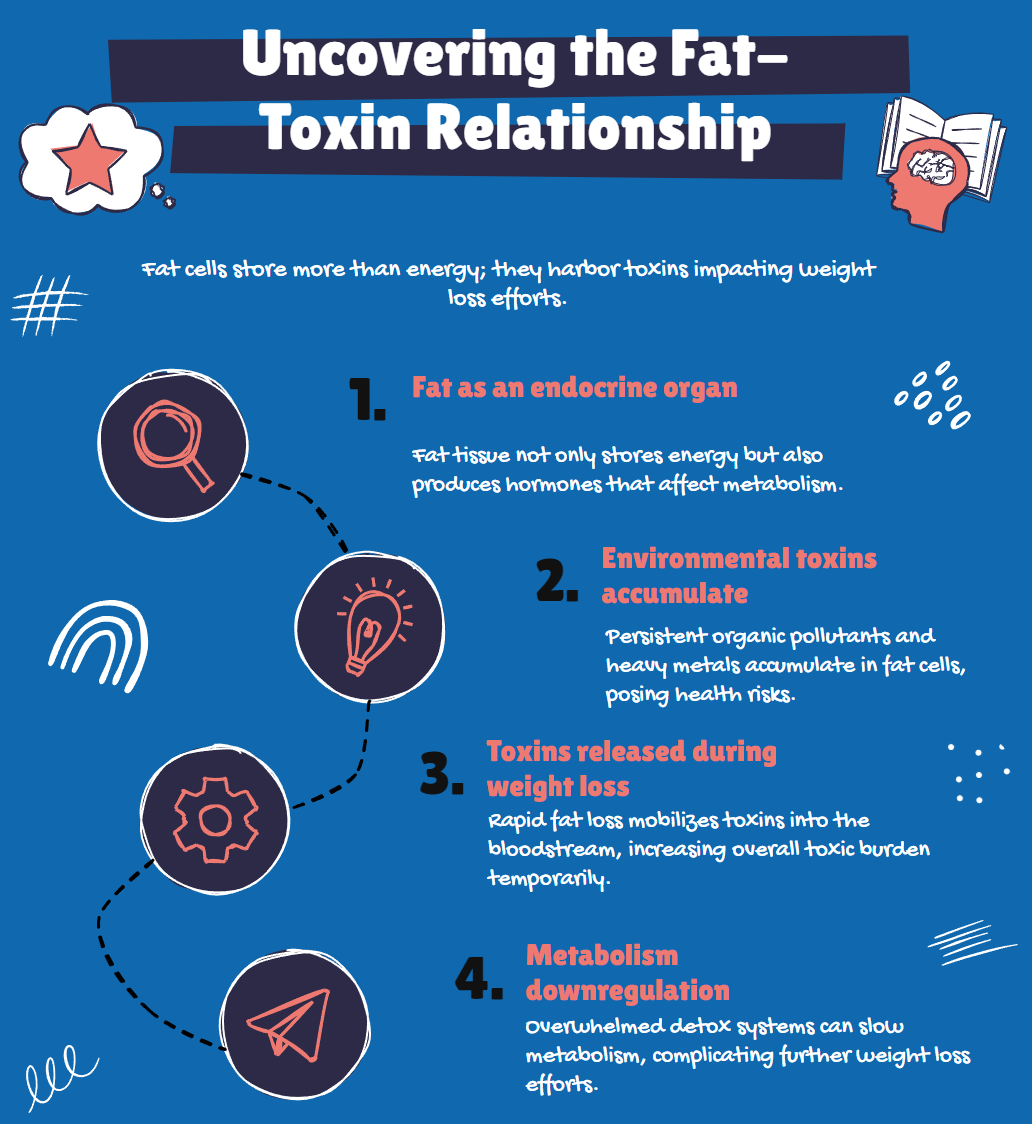
Why Fat Loss Triggers Toxin Release And Weight Rebounds
Why Fat Loss Triggers Toxin Release And Weight Rebounds
Bodies store secrets. Hidden within our fat cells lies a complex relationship most weight loss programs never address. When fat breaks down, it doesn't just disappear. It releases stored compounds that can trigger a cascade of biological responses, potentially explaining why sustained weight loss proves so elusive for many.
The connection between fat cells, environmental toxins, and weight regulation represents one of the most overlooked aspects of metabolic health. This relationship doesn't just complicate weight loss efforts - it fundamentally challenges our understanding of what sustainable body transformation requires.
Fat Cells Do More Than Store Energy
Fat tissue serves as more than just an energy reserve. It functions as an endocrine organ, producing hormones while also acting as a storage site for fat-soluble compounds that cannot be immediately processed by the body. Among these compounds are persistent organic pollutants (POPs), heavy metals, and other environmental toxins that accumulate through everyday exposure.
These toxins preferentially bind to fat tissue because they're lipophilic - literally "fat-loving." The body, in its wisdom, sequesters these potentially harmful substances in fat cells as a protective mechanism, keeping them away from vital organs and systems.
When we maintain stable weight, this storage system works effectively. But what happens when we start losing significant amounts of body fat?
The Toxin Release Mechanism
During active weight loss, as fat cells shrink and break down, they release their contents into the bloodstream. This includes not just the stored energy but also the accumulated toxins that have been safely tucked away, sometimes for years or even decades.
Research published in the International Journal of Obesity demonstrates that blood levels of organic pollutants increase during periods of weight loss. One study found that individuals losing weight through caloric restriction showed a 23-51% increase in serum concentrations of certain POPs, with levels proportional to the amount of weight lost.
This sudden mobilization creates a paradoxical situation: the very process of getting healthier temporarily increases the body's toxic burden.
The Metabolic Defense Response
The body responds to this flood of released toxins through several mechanisms that, unfortunately, can work against long-term weight management goals:
First, the liver and detoxification systems become burdened with processing these compounds. When overwhelmed, the body may downregulate metabolism as a protective measure, making further weight loss more difficult.
Second, many environmental toxins act as endocrine disruptors, interfering with hormones that regulate hunger, satiety, and fat storage. This disruption can increase cravings and reduce energy expenditure.
Third, inflammation typically increases as these compounds circulate, triggering water retention and stress responses that further complicate weight management.
Perhaps most significantly, the body may actually resist further fat loss as a protective mechanism. From an evolutionary perspective, if toxin release is perceived as threatening, preserving remaining fat tissue becomes a survival priority.
Breaking the Cycle
Understanding this connection shifts how we should approach sustainable weight management. Rather than viewing weight regain as simply a failure of willpower, we can recognize it as partly a biological response to toxin mobilization.
This perspective suggests several strategic approaches:
Gradual weight loss may be preferable to rapid fat reduction, giving the body's detoxification systems time to process released compounds without becoming overwhelmed. Research suggests that losing 1-2 pounds per week might represent the sweet spot for many individuals.
Supporting natural detoxification pathways becomes crucial during active weight loss. The liver, kidneys, digestive system, skin, and lungs all participate in eliminating toxins. Ensuring adequate hydration, fiber intake, and nutrients that support liver function can help manage the increased toxic load.
Reducing ongoing toxin exposure creates less competition for detoxification resources. This includes being mindful of food containers, household products, personal care items, and other common sources of environmental toxins.
Stress management practices become particularly important during weight loss, as cortisol can both interfere with detoxification and promote fat storage, especially around the midsection.
A New Paradigm for Weight Management
This understanding of the fat-toxin connection suggests we need a more sophisticated approach to weight management than simply "eat less, move more." Successful long-term weight management might require supporting the body's detoxification capacity alongside traditional approaches to diet and exercise.
For health professionals, this means considering toxin burden when designing weight loss protocols, particularly for individuals who have experienced the frustrating pattern of weight loss followed by inexplicable regain.
For individuals, it means recognizing that some challenges in maintaining weight loss may have biochemical origins rather than representing personal failure.
The science in this area continues to evolve, but the evidence increasingly suggests that addressing the release of stored toxins during weight loss may be a missing link in creating truly sustainable approaches to metabolic health.
Weight management isn't just about calories. It's about creating an internal environment where the body feels safe releasing fat stores without triggering protective mechanisms. By understanding and addressing the hidden connection between fat loss, toxin release, and weight regulation, we open new possibilities for breaking through plateaus and maintaining healthy weight for life.
